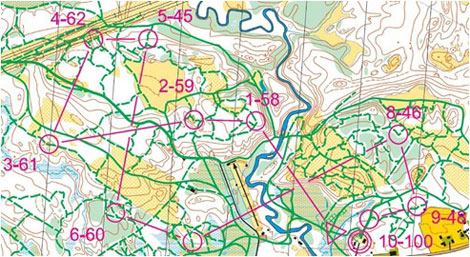Home > Arc Communications Ski Team > Description of Ski Orienteering
Description of Ski Orienteering
Intelligence x Physical Strength x Skiing Ability
Ski orienteering is a highly exciting winter sport that combines cross-country skiing and orienteering as participants use a map to ski through snowy mountains.
Participants navigate complex, maze-like mountain courses that have been created by snowmobiles, reading a map in a holder hanging from their necks as they make split-second decisions about which path to take. Because a difference of only 0.1 second separates the racers, the athletes continue to ski from start to finish without stopping.
Because skiers move along while selecting their own course, the key to victory is the intelligence to select the best route without hesitation and the physical strength and skiing ability to race along at high speed.
The most difficult point is the requirement to determine your own route, unlike a marathon or conventional cross-country skiing, which use a set course. It is also the point of greatest appeal of the sport.
Ski orienteering is particularly popular in Europe, and there are World Championships and World Cups held in the sport. It is the orienteering competition that is considered to have the highest possibility of adoption as an Olympic event.
As is the case with cross-country skiing, races come in a variety of distances, with sprint being the shortest, then middle, and finally long.

Basic Rules
- Competition is between individual times.
- A map is distributed 15 seconds before the start.
- Skiers pass in order through designated locations (checkpoints).
- An electronic system similar to the one used in Suica cards is used at each checkpoint to record the time at which skiers pass.
- The route used to go from one designated location (checkpoint) to the next is left up to the individual skier.
- Entrance to the competition area is prohibited until the start of the race.
Equipment
- Cross-country skis, shoes, and poles are used.
- A map holder is used to place the map in front of the skier's chest without requiring the use of hands. Skiers view the map while skiing.
- Wax is also an important element that impacts finishing order.
Maps
- Special orienteering maps are used.
- △ indicates the starting point, and areas inside a ○ are the checkpoints.
- Paths hardened by snow groomers or snowmobiles are indicated by green lines.
- Line types indicate the width of the paths, and significantly affect the speed of skiing.

Please see the website of the International Orienteering Federation for details regarding the sport.


